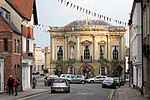Oddfellows' Hall, Devizes
1873 establishments in EnglandBuildings and structures in WiltshireDevizesGrade II listed buildings in WiltshireOdd Fellows buildings in the United Kingdom ... and 1 more
Use British English from May 2022
The Oddfellows' Hall in Devizes, Wiltshire, England is a Grade II Listed building constructed in 1873 by the Odd Fellows Society.
Excerpt from the Wikipedia article Oddfellows' Hall, Devizes (License: CC BY-SA 3.0, Authors).Oddfellows' Hall, Devizes
Maryport Street,
Geographical coordinates (GPS) Address Nearby Places Show on map
Geographical coordinates (GPS)
| Latitude | Longitude |
|---|---|
| N 51.3519 ° | E -1.99223 ° |
Address
Boss Barber
Maryport Street 16a
SN10 1AH
England, United Kingdom
Open on Google Maps









